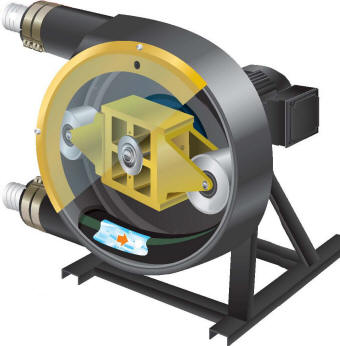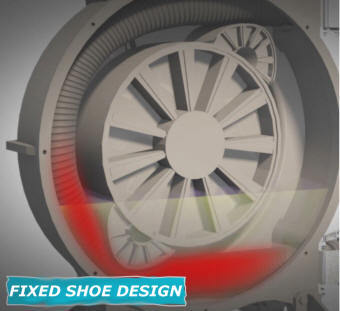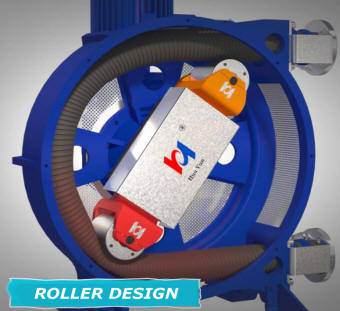Peristaltic Pumps for Industrial Applications


Peristaltic pump hoses are specially designed for repeated compression, having multiple layers to ensure resiliency. Eventually fatigue stress results in reduced displacement and if the hose is not replaced, eventually the hose might crack. For this reason most peristaltic pump installations are set-up to have a suction lift rather than having a flooded suction to minimize potential of fluid leakage in the event of a damaged hose.
With hose sizes from 3/8" to 4" we can cover a range of flow rates from 3 gallons per hour up to 455 gallons per minute. Since there are no seals, valves, dead corners or glands, peristaltic pumps are ideal for transferring abrasive, caustic, particulate laden raw materials, including effluent and highly viscous products.
A peristaltic pump hose is compressed with either a fixed shoe or a roller. Until recently a shoe design was required for higher pressures, however we now offer roller designs capable of those same pressures.


Roller style peristaltic pumps generate less friction (heat) than shoe models during hose compression and this helps extend hose life. Unlike shoe style peristaltic pumps which require a liquid glycerin lubricant to reduce friction related hose wear, roller style peristaltic pumps only require a silicon grease, so there's less chance for fugitive emissions while hose changes are easier and not as messy. Roller style pumps are often preferred for pure fluids or food related products due to reduced potential for lubrication related cross contamination.
A benefit of shoe style peristaltic pumps is that their hose design does not need to be as complex, thus the cost for replacement hoses might be less.
Please read our article describing the characteristics of industrial peristaltic pumps for additional information about peristaltic pump and hose design. You might also be interested in our article Peristaltic Pump Applications.
We typically review the design criteria which you submit to us via our peristaltic pump inquiry form and recommend the most appropriate design.
Three Models of Peristaltic Pumps
- The Vector 2000 series peristaltic pump has a roller design and is applied to applications requiring lower pressures, less than 100 PSI at flow rates as high as 211 GPM.
- The Hua Yun IHP series peristaltic pump also has a roller design, but due to an upgraded housing design meant to disperse heat and reduce compression friction, these can be used for pressures up to 200 PSI and flow rates as high as 445 GPM.
- The Vector 4000 series peristaltic pump has a shoe design with glycerin lubricant in support of pressures up to 200 PSI and flow rates as high as 135 GPM.
Regardless of the
hose compression design, the five main advantages of industrial
peristaltic pumps include:
- There are no seals to wear out, inventory or replace. Only the hose is in contact with the fluid pumped, so with a compatible hose material and proactive hose replacement reliability is fantastic and maintenance costs minimal.
- They have great suction lift capabilities, which is beneficial for many transfer applications where fluids or slurries are transferred from a tote, tanker or holding tank to a process or some other container.
- Peristaltic pumps tolerate relatively large solids, minimizing filtration requirements. This also makes them ideal for transferring reclaimed fluids; a big application for peristaltic pumps is dockside transfer of raw sewage to temporary storage tanks.
- Peristaltic pumps can be operated dry as they are not dependent upon the fluid being pumped for cooling or lubrication. This simplifies a fluid system by eliminating low liquid level sensing equipment in some circumstances and reduces product waste for transfer applications.
- Compared to air operated diaphragm pumps, peristaltic pumps do not require compressed air, will not stall when run at low RPM's and operate equally well in both hot and cold weather.
- The pumping direction for peristaltic pumps can be reversed in support of using one pump for both filling and transfer applications.
The following links are organized by flow rate and pressure, each page contains specific information about that pump model, including its pump curve and catalog pages.
| 2000 Series (low pressure) |
4000 Series (Shoe, high pressure) |
IHP Series
(Roller, high pressure) |
|
2002: ≤ 18 GPH ≤ 30 PSI |
4003: ≤ 39 GPH and 110 PSI |
IHP5Z, IHP10Z, IHP15Z ≤ 26 GPH ≤ 174 PSI |
|
2003: ≤ 1 GPM ≤ 20 PSI |
4004: ≤ 2 GPM and 110 PSI |
|
|
2004: ≤ 2.50 GPM ≤ 45 PSI |
3005: ≤ 9.00 GPM and 200 PSI |
IHP20Z, IHP25Z, IHP32Z ≤ 11.5 GPM ≤ 232 PSI |
|
2005: ≤ 6.00 GPM and 50 PSI |
4006: ≤ 9 GPM ≤ 218 PSI |
|
|
2006: ≤ 14.0 GPM and 60 PSI |
4007: ≤ 16 GPM ≤ 218 PSI |
IHP40Z, IHP50Z, IHP65Z ≤ 106 GPM ≤ 232 PSI |
|
2007: ≤ 40.0 GPM and 60 PSI |
4009: ≤ 36 GPM ≤ 218 PSI |
|
|
2008: ≤ 50.0 GPM and 100 PSI |
4010: ≤ 58 GPM ≤ 218 PSI |
|
|
2009: ≤ 120 GPM and 100 PSI |
4014: ≤ 135 GPM ≤ 218 PSI |
IHP80Z, IHP90Z, IHP100Z ≤ 222 GPM ≤ 232 PSI |
|
2010: ≤ 211 GPM and 116 PSI |
IHP265Z, IHP280Z, IHP290Z,
IHP2100Z ≤ 445 GPM ≤ 232 PSI |




